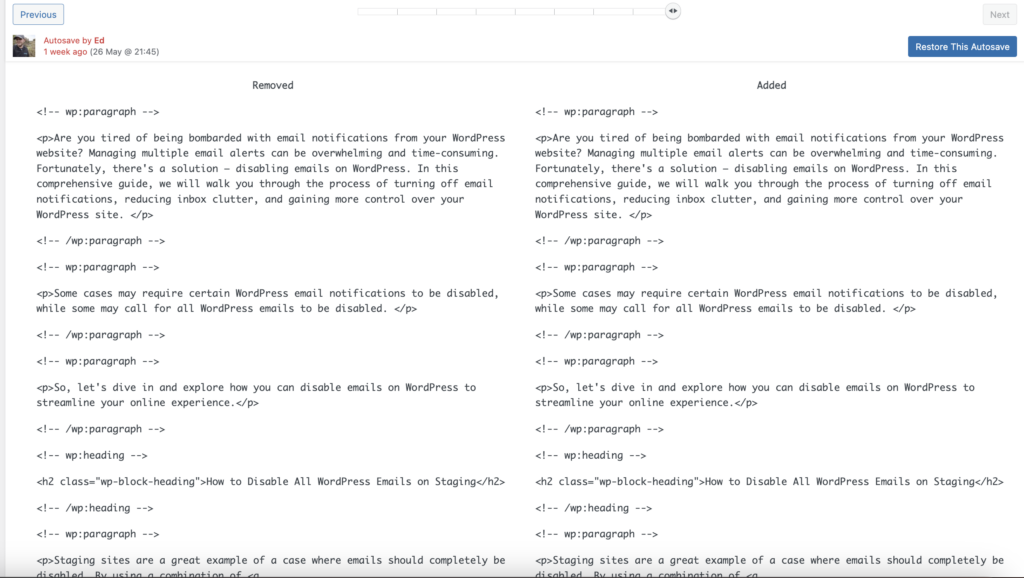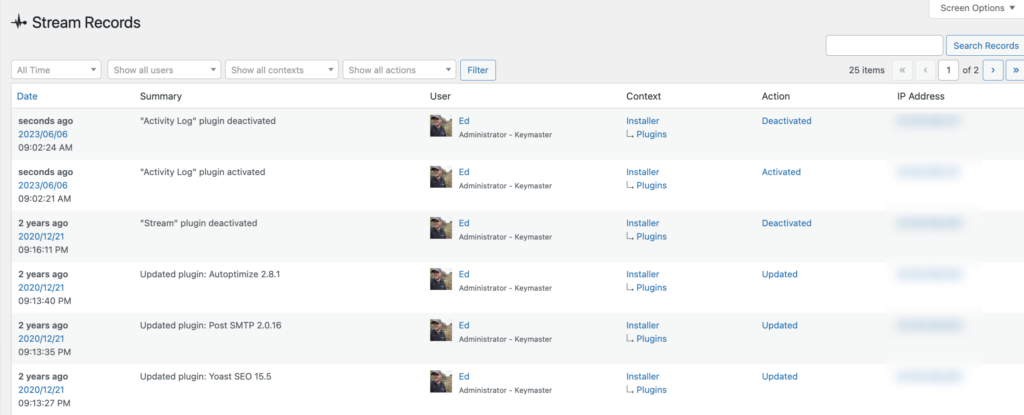WordPress, the popular content management system (CMS), offers a wide range of features to help website owners manage and maintain their online presence. One such important feature missing is the ability to track changes made to your WordPress website. Keeping track of changes can be extremely useful, especially when multiple users are involved in managing the site or when you need to monitor and review modifications made over time due to malware infection or unauthorized access. In this comprehensive guide, we will explore various methods and tools to effectively track changes in WordPress, ensuring you have full control and visibility over your website’s evolution.
Why is Tracking Changes Important?
As a website owner, it is crucial to have a clear understanding of any modifications made to your WordPress site. Tracking changes allows you to:
- Monitor content updates, plugin installations, and theme modifications.
- Identify unauthorized changes or potential security breaches.
- Roll back to a previous version in case of errors or unwanted alterations.
- Collaborate with multiple users, ensuring transparency and accountability.
- Comply with industry regulations that require change tracking and auditing.
Native WordPress Revisions
WordPress has a built-in feature called Revisions that automatically tracks changes made to posts and pages. It saves previous versions of your content, allowing you to compare and revert back to an earlier state if needed. To access revisions, follow these steps:
- Open the post or page you want to track changes for in the WordPress editor.
- Click on the Post tab in the right sidebar.
- Scroll down to the Revisions section.

Here, you can view the revisions made to the content, including who made the changes and the time of modification. You can also compare different revisions and restore a previous version if necessary.
While WordPress revisions provide basic tracking functionality, they have certain limitations. They only track changes to content and do not monitor other important aspects like plugin activations or theme modifications. To overcome these limitations and gain more advanced tracking capabilities, plugins can be used.
Using Plugins for Change Tracking
WP Activity Log
To track changes in WordPress using the WP Activity Log plugin, follow these steps:
- Install and activate the WP Activity Log plugin from the WordPress Plugin Directory.
- Once activated, the plugin will start tracking changes automatically.
- Access the activity log by navigating to WP Activity Log → Activity Log in your WordPress dashboard.

The activity log displays a list of events and activities that have occurred on your website. Each log entry includes the user responsible for the action, the date and time of the event, and a description of the change made. You can use the search and filter options to find specific activities or generate reports based on different criteria.
wp plugin install wp-security-audit-log --activateSimple History
If you prefer a lightweight plugin for tracking changes, Simple History is a great option. Here’s how you can use it:
- Install and activate the Simple History plugin from the WordPress Plugin Directory.
- Once activated, the plugin will start recording events and activities.
- To view the activity log, go to Dashboard → Simple History in your WordPress admin area.

The activity log in Simple History provides a chronological view of events, making it easy to track changes. Each log entry includes details such as the user who performed the
action, the date and time of the event, and a brief description of the change made. You can navigate through the log entries and use the search functionality to find specific activities.
wp plugin install simple-history --activateStream
Stream is a comprehensive plugin that allows you to track changes made by users on your WordPress website. To use Stream for change tracking, follow these steps:
- Install and activate the Stream plugin from the WordPress Plugin Directory.
- Once activated, the plugin will begin tracking user activities automatically.
- To access the activity log, go to Stream → Stream in your WordPress dashboard.

The Stream activity log provides a detailed overview of user actions, including post modifications, plugin activations, settings changes, and more. You can filter the log based on different criteria, such as user, action type, or date range. This helps you easily identify and track specific changes made on your WordPress site.
wp plugin install stream --activate| Plugin | Features | Ease of Use | Flexibility |
|---|---|---|---|
| WP Activity Log | Tracks a wide range of activities and provides detailed logs | Easy to use | Highly flexible |
| Simple History | Lightweight plugin with a simple interface | Extremely easy | Limited customization |
| Stream | Comprehensive tracking of user actions and events | Moderate | Customizable notifications |
| VersionPress | Git-like version control integrated with WordPress | Advanced | Suitable for developers |
Each change tracking method and plugin offers its own set of features and benefits. Consider your specific requirements and preferences when choosing the most suitable option for your WordPress site.
Benefits of Change Tracking
Tracking changes in WordPress brings several benefits to website owners and administrators. Here are some key advantages:
Transparency and Accountability: Change tracking promotes transparency by providing a clear record of who made what changes and when. It holds users accountable for their actions, ensuring that modifications are authorized and audited.
Error Identification and Rollback: With change tracking, you can easily identify and rectify errors or unintended changes. By reverting to a previous version, you can restore your website to a stable state and minimize any negative impact.
Improved Collaboration: When multiple users are involved in managing a WordPress site, change tracking enables effective collaboration. Users can view and review each other’s changes, fostering better communication and coordination.
Security and Compliance: Tracking changes helps enhance security by monitoring and identifying unauthorized or suspicious activities. It also aids in compliance with industry regulations that require change tracking and auditing.
Efficient Troubleshooting: When issues arise on your WordPress site, change tracking provides valuable information for troubleshooting. By analyzing the log of changes, you can pinpoint the source of the problem and take appropriate action.
Common Use Cases for Change Tracking
Change tracking in WordPress finds relevance in various scenarios. Here are some common use cases:
Content Management: Tracking changes to posts and pages is essential for content management. It allows you to monitor content updates, revisions, and deletions, ensuring content accuracy and consistency.
Plugin and Theme Management: Change tracking helps monitor plugin and theme installations, activations, deactivations, and updates. It enables you to keep track of changes that may affect your website’s functionality or security.
User Activity Monitoring: By tracking user activities, you can identify suspicious behavior or unauthorized access attempts. It helps maintain the security of your WordPress site and protects sensitive data.
Troubleshooting and Debugging: When encountering issues or bugs on your site, change tracking provides a historical record that aids in troubleshooting. You can trace back the changes made and identify potential causes of the problem.
Compliance and Auditing: Certain industries and regulations require websites to maintain an audit trail of changes. Change tracking helps fulfill these compliance requirements and facilitates auditing processes.
Tracking WP Changes FAQs
How often does WordPress save revisions?
WordPress saves revisions whenever you make changes to a post or page. By default, it saves revisions every 60 seconds. However, you can modify the autosave interval using plugins or manual code adjustments.
Can I track changes made by specific users?
Yes, most change-tracking plugins allow you to filter and search for activities based on specific users. You can track changes made by individual users and monitor their actions on your WordPress site.
Can change tracking plugins slow down my site?
Change-tracking plugins generally have minimal impact on site performance. However, some plugins with extensive tracking capabilities may slightly increase the database size, which can affect site performance in rare cases. It is recommended to choose lightweight and well-optimized plugins to ensure smooth site operation.
Can I receive notifications for specific changes?
Yes, many change-tracking plugins offer notification features. You can configure email notifications or real-time alerts for specific types of changes or events. This allows you to stay informed about critical modifications happening on your WordPress site.
Can I export the change logs for further analysis?
Absolutely! Most change tracking plugins provide the option to export the activity logs in various formats, such as CSV or PDF. You can export the logs and analyze them using external tools or share them with auditors for compliance purposes.
Are there any free change-tracking plugins available?
Yes, there are several free change-tracking plugins available in the WordPress Plugin Directory. Plugins like WP Activity Log and Simple History offer free versions with essential tracking features. However, some advanced functionalities may be available only in premium or pro versions of the plugins.









[…] Document Changes and Experiments: Maintain a log or documentation of the changes, experiments, and tests performed on the staging site. This makes it easier to track and revert changes if needed and provides a reference for future development. How to Track Changes in WordPress […]
[…] When experiencing user-related hacks, reset all WP admin passwords, implement 2 factor-authentication, and setup a security logging plugin. […]